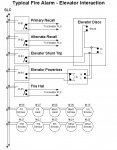- Location
- Windsor, CO NEC: 2017
- Occupation
- Service Manager
I'm trying to remember all aspects of a typical elevator - fire alarm interaction. What am I forgetting?
It seems to me that there is sometimes a relay in addition to primary and alternate recalls for Schindler elevators, and I'm not remembering what the heck it does.
- Primary Recall Relay
- Alternate Recall Relay
- Elevator Shunt Trip Relay
- Elevator Powerloss Monitor
- Heat in Pit/Top of Shaft
- Smoke in Pit/Top of Shaft
- Heat in Control/Machinery Rm
- Smoke in Control/Machinery Rm
It seems to me that there is sometimes a relay in addition to primary and alternate recalls for Schindler elevators, and I'm not remembering what the heck it does.




